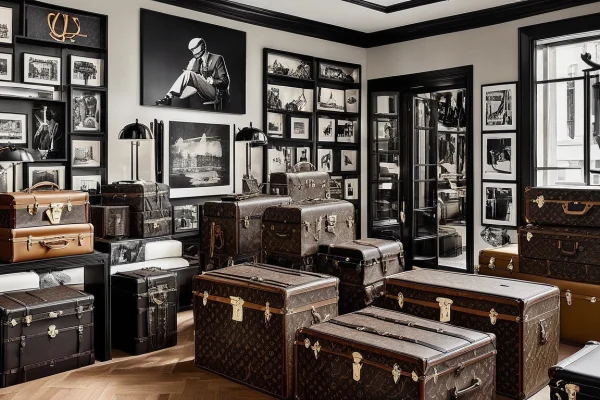Who Inspired the Luxury Legacy of Louis Vuitton?

The story of Louis Vuitton is not just about luxury; it’s a tapestry woven from the threads of innovation, artistry, and ambition. Founded in the 19th century, Louis Vuitton has become a beacon of elegance and sophistication, attracting a global clientele that craves the finest things in life. But who are the visionaries and events that shaped this iconic brand’s legacy? Let’s dive into the rich heritage that has inspired the luxury legacy of Louis Vuitton.
At the heart of this legacy is Louis Vuitton himself, a man whose journey began as a humble trunk maker. His innovative designs and craftsmanship set the stage for a brand that would eventually redefine luxury. Vuitton was not just creating luggage; he was crafting an experience, a way of life that spoke to the elite of society. His dedication to quality and style laid the groundwork for what would become a global powerhouse in the fashion industry.
Throughout its history, Louis Vuitton has engaged in influential collaborations that have propelled the brand to new heights. These partnerships have not only enhanced its reputation but also broadened its appeal. For example, collaborations with renowned artists and designers have infused fresh perspectives into the brand, keeping it relevant in an ever-evolving market. Here are some key collaborations that shaped the brand:
- Takashi Murakami – Merging art with fashion
- Yayoi Kusama – A vibrant explosion of polka dots
- Jeff Koons – Transforming classic art into luxury accessories
Moreover, the artistic directors at Louis Vuitton have played a pivotal role in shaping its creative direction. From the bold vision of Marc Jacobs in the late 1990s, who seamlessly blended high fashion with street style, to Nicolas Ghesquière, who has redefined the brand’s aesthetic while paying homage to its heritage, each director has left an indelible mark on the brand.
As we examine the historical context, it’s essential to consider how the rise of travel culture in the late 19th century opened doors for Louis Vuitton. The brand transformed into a symbol of luxury and sophistication, catering to a clientele eager to travel in style. This evolution was not just about products but also about adapting to cultural shifts and consumer demands over the decades.
In summary, the luxury legacy of Louis Vuitton is a rich narrative filled with inspiring figures, innovative collaborations, and a keen awareness of cultural trends. It’s a story that continues to unfold, captivating new generations of luxury consumers around the world.
The Visionary Founder
Louis Vuitton, the visionary founder of the iconic brand, was not just a craftsman; he was a pioneer whose dreams soared beyond the ordinary. Born in 1821 in rural France, Louis had a humble beginning, but his ambitions were anything but modest. He moved to Paris at the tender age of 14, where he quickly became an apprentice to a box maker. This experience ignited his passion for craftsmanship and design, laying the groundwork for what would become a luxury empire.
What set Louis apart was his innovative spirit. In an era when travel was becoming increasingly popular among the elite, he recognized a gap in the market for high-quality luggage. His introduction of flat-topped trunks in 1858 was a game changer. Unlike the rounded tops that were common at the time, Louis’s design allowed for easier stacking, making it practical for travelers. This innovation not only showcased his creativity but also established the brand’s reputation for functionality and elegance.
To illustrate the impact of Louis Vuitton’s innovations, here’s a quick table highlighting key milestones:
| Year | Milestone |
|---|---|
| 1854 | Founded the Louis Vuitton brand |
| 1858 | Introduced the flat-topped trunk |
| 1896 | Launched the iconic monogram canvas |
Louis’s vision extended beyond just creating beautiful products. He believed in the power of branding and the significance of a strong identity. The introduction of the now-famous monogram canvas in 1896 was not merely a design choice; it was a strategic move to protect against counterfeiting and to establish a recognizable logo that would become synonymous with luxury. This foresight laid the foundation for the brand’s enduring legacy.
As we look back, it’s clear that Louis Vuitton was not just a man; he was a visionary whose innovative ideas and relentless pursuit of excellence have left an indelible mark on the world of luxury fashion. His legacy continues to inspire and influence the industry, proving that true craftsmanship and a bold vision can create something timeless.
Influential Collaborations
The world of Louis Vuitton is not just about luxury; it’s also about the power of collaboration. Over the years, the brand has engaged in numerous partnerships that have not only elevated its status but have also redefined the boundaries of fashion. From artists to designers, these collaborations have infused fresh creativity into the brand, helping it maintain its relevance in an ever-changing industry.
One of the most significant aspects of these collaborations is how they blend different artistic visions, creating products that are both innovative and timeless. For instance, the partnership with renowned artist Takashi Murakami in the early 2000s introduced a vibrant twist to the classic monogram canvas, showcasing how art can transform luxury fashion. This collaboration wasn’t just a marketing strategy; it was a cultural moment that resonated with a younger audience, making luxury accessible and exciting.
Another pivotal collaboration was with streetwear icon Supreme. This partnership brought together two seemingly disparate worlds—high fashion and street culture—resulting in a collection that sold out almost instantly. It was a bold move that not only expanded Louis Vuitton’s reach but also solidified its status as a trendsetter in the fashion realm.
To illustrate the impact of these collaborations, let’s take a look at some noteworthy partnerships:
| Collaboration | Year | Impact |
|---|---|---|
| Takashi Murakami | 2003 | Revitalized the monogram canvas with vibrant colors and designs. |
| Supreme | 2017 | Blended streetwear with luxury, attracting a younger demographic. |
| Jeff Koons | 2017 | Created a line of bags featuring famous artworks, merging art with fashion. |
These collaborations are not merely business ventures; they are a testament to Louis Vuitton’s commitment to innovation and creativity. By continuously seeking out visionary partners, the brand not only stays ahead of trends but also inspires a new generation of luxury consumers. So, the next time you see a Louis Vuitton piece, remember that it’s not just a product—it’s a collaboration of ideas and artistry that has shaped the luxury legacy we know today.
Artistic Directors
The journey of Louis Vuitton is not just a tale of luxury goods, but also a narrative woven with the creativity and vision of its . Each director has played a pivotal role in shaping the brand’s identity, bringing their unique flair and innovative ideas to the table. It’s fascinating to see how these figures have transformed the brand while keeping its rich heritage intact. Their contributions have not only impacted the products but have also redefined the way we perceive luxury in a modern context.
One of the most significant aspects of their roles has been the ability to merge traditional craftsmanship with contemporary aesthetics. For instance, Marc Jacobs, who took the helm in the late 1990s, is credited with introducing a fresh perspective that appealed to a younger audience. His collaborations with artists and designers created a buzz that resonated within the fashion community and beyond. This was a time when high fashion began to embrace street style, and Jacobs was at the forefront of this revolution.
Following in his footsteps, Nicolas Ghesquière brought a new wave of innovation. His vision was not just about modernizing the brand but also about respecting its legacy. Ghesquière skillfully blended the classic elements of Louis Vuitton with futuristic designs, ensuring that the brand remained relevant in a rapidly evolving fashion landscape. His work exemplifies how artistic directors can serve as both custodians and innovators, balancing tradition with modernity.
| Artistic Director | Tenure | Key Contributions |
|---|---|---|
| Marc Jacobs | 1997 – 2013 | Introduced street style, collaborated with artists, expanded product lines. |
| Nicolas Ghesquière | 2013 – Present | Modernized aesthetics, respected heritage, innovative designs. |
In conclusion, the influence of these artistic directors cannot be overstated. They have not only shaped the luxury legacy of Louis Vuitton but have also influenced the broader fashion industry. As we look to the future, it will be exciting to see how the next generation of creative leaders will continue to evolve this iconic brand.
Marc Jacobs’ Impact
When we think of Louis Vuitton, the name Marc Jacobs often comes to mind as a pivotal figure who reshaped the brand’s identity in the late 1990s. His arrival at Louis Vuitton marked a turning point, where he seamlessly blended high fashion with street style, inviting a fresh wave of consumers into the luxury fold. Can you imagine a world where luxury is not just for the elite, but also for the trendsetters on the streets? Jacobs made that a reality.
Jacobs’ innovative approach included collaborations with artists and designers, which not only elevated the brand’s profile but also made it accessible to a younger audience. He famously partnered with the likes of Stephen Sprouse and Takashi Murakami, introducing vibrant colors and playful designs to the traditional luxury aesthetic. These collaborations resulted in iconic pieces that became must-haves, showcasing how art and fashion could coexist.
| Collaboration | Year | Impact |
|---|---|---|
| Stephen Sprouse | 2001 | Graffiti print bags that redefined luxury streetwear. |
| Takashi Murakami | 2003 | Colorful Monogram Multicolore that appealed to a younger demographic. |
Under Jacobs’ leadership, the brand launched its first-ever ready-to-wear collection, which was a game changer. This move not only diversified Louis Vuitton’s offerings but also positioned it firmly in the realm of fashion, rather than just luxury goods. It was a bold statement: Louis Vuitton was not just a heritage brand; it was a trendsetter.
In the words of Jacobs himself, “Fashion is about dreaming and making other people dream.” His vision and creativity transformed Louis Vuitton into a symbol of contemporary luxury, appealing to those who seek both elegance and modernity. Thanks to Marc Jacobs, Louis Vuitton is not just about bags and luggage anymore; it’s about a lifestyle that resonates with a diverse audience.
Nicolas Ghesquière’s Vision
Nicolas Ghesquière stepped into the role of Creative Director at Louis Vuitton in 2013, bringing a fresh perspective that would not only redefine the brand’s aesthetic but also set a new standard in the luxury fashion industry. His vision was clear: to merge the heritage of Louis Vuitton with a modern twist that appealed to a younger, more diverse audience. Ghesquière’s approach was akin to a skilled conductor, harmonizing the brand’s rich history with contemporary elements, creating a symphony of style that resonated with consumers worldwide.
Under Ghesquière’s leadership, Louis Vuitton has embraced innovation while respecting its roots. He introduced bold silhouettes, intricate designs, and unexpected materials, transforming traditional luxury into something that feels both fresh and timeless. His collections often reflect a deep understanding of the cultural zeitgeist, making Louis Vuitton not just a brand, but a cultural phenomenon.
One of the hallmarks of Ghesquière’s tenure has been his ability to blend high fashion with everyday wear, making luxury accessible yet aspirational. For instance, his use of technical fabrics and modern aesthetics has attracted a new generation of fashion enthusiasts who crave both style and comfort. This shift has been crucial in maintaining the brand’s relevance in an ever-evolving market.
| Key Elements of Ghesquière’s Vision | Description |
|---|---|
| Innovation | Incorporating new materials and techniques into designs. |
| Heritage | Respecting the traditional craftsmanship of Louis Vuitton. |
| Accessibility | Creating designs that appeal to a younger audience. |
| Cultural Relevance | Reflecting current trends and societal changes in collections. |
Ghesquière’s work has not gone unnoticed. He has received numerous accolades for his innovative designs, cementing his status as one of the most influential figures in modern fashion. In his own words, he stated, “Fashion is a way to express yourself and connect with the world around you.” This philosophy is evident in every collection he curates, making Louis Vuitton a true leader in luxury.
As we look to the future, Ghesquière’s vision continues to inspire not only the brand but also the entire fashion industry. His ability to blend the past with the future ensures that Louis Vuitton remains a beacon of luxury and creativity.
Iconic Products
When you think of Louis Vuitton, certain products immediately spring to mind, each a testament to the brand’s legacy of luxury and craftsmanship. The monogram canvas, for instance, is not just a pattern; it’s a symbol of status and sophistication. Introduced in the late 19th century, this iconic design has transcended generations, becoming a staple in the wardrobes of fashion enthusiasts worldwide. But the brand’s offerings go beyond mere aesthetics; they embody a rich history and a commitment to quality.
Among the most celebrated products are:
- Speedy Bag: A timeless classic, the Speedy bag combines functionality with elegance, making it a favorite for both everyday use and special occasions.
- Neverfull Tote: This versatile tote is perfect for anyone on the go, offering ample space without sacrificing style.
- Keepall Duffle: Originally designed for travel, the Keepall has become synonymous with luxury travel, often seen in the hands of celebrities and jet-setters alike.
Each of these items is not just a product; they are pieces of art, crafted with precision and care. The materials used are top-notch, ensuring that every bag, wallet, or accessory not only looks good but also stands the test of time. For instance, the leather used in Louis Vuitton products undergoes rigorous quality checks, ensuring that it meets the highest standards.
To further illustrate the impact of these iconic products, here is a table showcasing some of the most popular items and their unique features:
| Product | Features | Year Introduced |
|---|---|---|
| Speedy Bag | Classic design, multiple sizes, durable canvas | 1930 |
| Neverfull Tote | Reversible, lightweight, spacious | 2007 |
| Keepall Duffle | Travel-friendly, iconic shape, multiple sizes | 1930 |
In summary, the of Louis Vuitton are not just items; they are symbols of luxury that tell a story of heritage, craftsmanship, and innovation. As the brand continues to evolve, these products will remain at the heart of its identity, captivating new generations of luxury consumers.
Historical Context
The evolution of Louis Vuitton is not just a story of luxury; it’s a reflection of the historical and cultural shifts that have shaped society. From its humble beginnings in the 19th century, the brand has navigated through significant events that have influenced its identity and offerings. The late 1800s marked a turning point, as the rise of travel culture opened new avenues for luxury goods, allowing Louis Vuitton to establish itself as a symbol of sophistication and adventure.
As the world embraced exploration, Louis Vuitton’s travel trunks became essential for the elite. These trunks were not merely functional; they were a statement of status. The brand’s innovative designs, like the flat-topped trunk, revolutionized how people traveled. This era was pivotal, as it positioned Louis Vuitton at the forefront of luxury travel, catering to a clientele that valued both style and practicality.
| Year | Event | Impact on Louis Vuitton |
|---|---|---|
| 1854 | Foundation of Louis Vuitton | Established the brand’s commitment to craftsmanship. |
| 1896 | Launch of the Monogram Canvas | Created an iconic visual identity. |
| 1920s | Rise of Travel Culture | Increased demand for luxury travel goods. |
Moreover, the fashion industry evolution during the 20th century played a crucial role in shaping Louis Vuitton’s strategies. The brand adapted to changing consumer demands, embracing new styles while staying true to its heritage. For instance, during the post-war period, as society shifted towards a more casual lifestyle, Louis Vuitton began to diversify its product offerings, introducing ready-to-wear collections that appealed to a broader audience.
In essence, the historical context surrounding Louis Vuitton is a tapestry woven with threads of innovation, culture, and societal changes. This rich backdrop not only enhances the brand’s narrative but also underscores its ability to evolve while maintaining its luxurious essence. As we delve deeper into the brand’s story, it becomes clear that understanding its historical context is key to appreciating the luxury legacy of Louis Vuitton.
The Rise of Travel Culture
The late 19th century marked a significant turning point in the world of travel, and with it, the rise of a culture that would forever change the luxury landscape. As the world became more interconnected, the concept of travel evolved from a mere necessity to a symbol of status and adventure. This shift created a fertile ground for brands like Louis Vuitton to flourish. Imagine the bustling train stations and luxurious ocean liners of the time, where the elite sought not just to travel, but to do so in style.
Louis Vuitton seized this opportunity by crafting exquisite travel trunks that were not only functional but also fashionable. The brand’s innovative designs and high-quality materials set it apart from competitors, making it the go-to choice for discerning travelers. In fact, the introduction of the iconic monogram canvas was a game-changer, allowing the brand to establish a strong identity in a crowded market.
As travel became more accessible, the demand for luxury goods skyrocketed. Louis Vuitton adapted its offerings to meet the changing needs of consumers, which included a growing desire for practicality without compromising style. The following table illustrates the evolution of travel culture and its impact on luxury brands:
| Year | Travel Milestone | Impact on Luxury Brands |
|---|---|---|
| 1854 | Introduction of the first flat trunk | Revolutionized luggage design |
| 1869 | Opening of the Suez Canal | Increased global travel opportunities |
| 1900 | Rise of luxury ocean liners | Demand for stylish travel accessories |
As travelers sought more than just a means to an end, they began to view their luggage as an extension of their identity. Louis Vuitton’s pieces became coveted status symbols, often flaunted as badges of honor among the elite. With every journey taken, the brand’s legacy grew, intertwining itself with the very essence of travel culture.
In conclusion, the rise of travel culture not only transformed how people experienced the world but also cemented Louis Vuitton’s place as a leader in luxury. The brand’s ability to adapt and innovate in response to changing consumer demands is a testament to its enduring legacy in the fashion industry.
Fashion Industry Evolution
The fashion industry has undergone a remarkable transformation over the decades, influencing brands like Louis Vuitton in profound ways. As societal norms shift and consumer preferences evolve, luxury brands have had to adapt to maintain their relevance. This evolution can be traced through several key phases, each marked by significant cultural and technological changes.
In the early 20th century, fashion was largely dictated by elite social classes, with exclusive designs that catered to the wealthy. However, as the post-war era emerged, a democratization of fashion began to take root. Suddenly, style was no longer reserved for the elite; it became accessible to the masses. Louis Vuitton, recognizing this shift, began to innovate by introducing more versatile and practical designs, appealing to a broader audience.
Fast forward to the digital age, and the fashion landscape has been revolutionized by technology. Social media platforms have changed how brands communicate with consumers, allowing for direct engagement and feedback. Louis Vuitton has adeptly navigated this new terrain, leveraging platforms like Instagram to showcase its collections and connect with a younger demographic. The brand’s ability to blend tradition with modern marketing strategies has solidified its status in a competitive market.
| Fashion Evolution Stages | Key Characteristics | Impact on Louis Vuitton |
|---|---|---|
| Early 20th Century | Exclusive, high-society fashion | Focus on luxury craftsmanship |
| Post-War Era | Democratization of fashion | Introduction of versatile designs |
| Digital Age | Social media influence | Direct engagement with consumers |
Moreover, the rise of sustainability in fashion has prompted brands to rethink their production methods. Louis Vuitton has made strides in this area, implementing eco-friendly materials and practices to appeal to the environmentally conscious consumer. This shift not only reflects changing consumer values but also positions the brand as a leader in responsible luxury.
In conclusion, the evolution of the fashion industry has been a dynamic journey, with each phase presenting both challenges and opportunities. Louis Vuitton’s ability to adapt and innovate amidst these changes is a testament to its enduring legacy. As we look to the future, one can only wonder how the brand will continue to shape and be shaped by the ever-evolving fashion landscape.
Frequently Asked Questions
- Who was Louis Vuitton?
Louis Vuitton was a visionary French craftsman and the founder of the luxury brand that bears his name. He began his career in the 19th century, creating high-quality luggage that catered to the needs of affluent travelers, establishing a legacy of craftsmanship and innovation.
- What role did Marc Jacobs play in Louis Vuitton’s history?
Marc Jacobs was instrumental in redefining Louis Vuitton in the late 1990s. He blended high fashion with street style, attracting a younger audience and helping to elevate the brand’s status in the fashion world. His creative direction marked a turning point that modernized the label.
- How has Louis Vuitton adapted to changing consumer demands?
Throughout its history, Louis Vuitton has evolved by embracing cultural shifts and trends. From the rise of travel culture to the integration of modern design elements, the brand has consistently innovated its product offerings to stay relevant in a competitive market.
- What are some iconic products from Louis Vuitton?
Some of the most iconic products from Louis Vuitton include the classic monogram canvas bags, leather goods, and travel trunks. These items have become symbols of luxury and sophistication, representing the brand’s commitment to quality and style.
- Who are the current artistic directors of Louis Vuitton?
As of now, Nicolas Ghesquière serves as the creative director for women’s collections, continuing to infuse modernity into the brand while honoring its rich heritage. His vision keeps Louis Vuitton at the forefront of the fashion industry.





